A group of Polish detectorists have uncovered an exciting collection of artifacts on the historic site of the Battle of Grunwald which took place in 1410. It includes two perfectly preserved battle axes that have been in the ground for over 600 years. It is hoped that these weapons can provide more insights into what was one of the most important battles in all medieval Europe.
The amazing weapons were found during a sweep of the battlefield site, which is in Northern Poland, by some 70 detectorists. It was organized by the Museum of the Battle of Grunwald and it is the 7 th year that the event has taken place. The detectorists, who are all volunteers, have made a number of important finds in the past. According to the report of the event by Zwiadoca Historii , their finds “bring us closer, and not in small steps, to an increasingly complete picture of the actual course of the battle.”
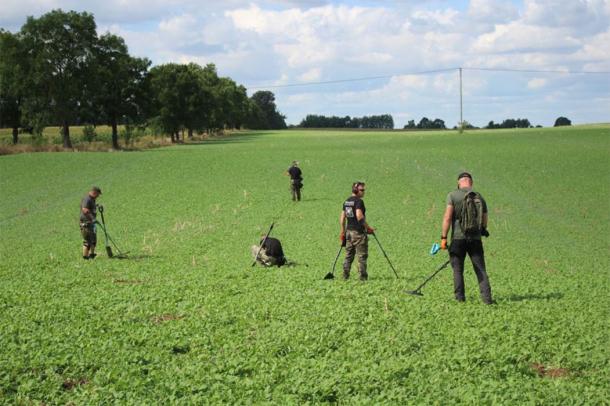
During the event, organized by the Museum of the Battle of Grunwald and now in it’s seventh year, about 70 volunteer metal detectorists conducted a huge sweep of the battlefield. Due to their high density, and organization working in rows, they made a series of important discoveries. ( Muzeum Bitwy pod Grunwaldem )
Battlefield Archaeology of the Battle of Grunwald
Professional archaeologists work with volunteers because of the size of the former battlefield, which covers an area of 100 hectares (247 acres). Adam Górecki, an archaeologist who participated in the investigation, told First News that, “The specificity of this place requires us to change our methods a little bit. We do not do it with the typical excavation method.” Many artifacts were found during the latest sweep including arrowheads, fragments of a sword, and bolts from the Battle of Grunwald . Some objects from later periods, such as the Napoleonic War , were also unearthed.
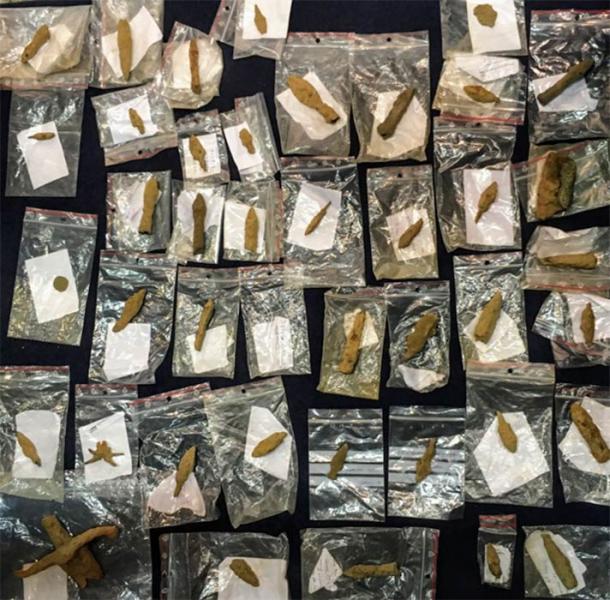
The sweep by volunteer metal detectorists unearthed large numbers of artifacts from the famous medieval battle in Poland. ( Zwiadowca Historii )
The most important finds of this season were the two battle axes. Zwiadoca Historii reports that they were found “at a depth of 70 cm (2.3 feet) in a swampy, anaerobic environment that stopped corrosion and oxidation of the metal.” This means that the axes were almost perfectly preserved, to the amazement of archaeologists. They were found by Alexander Miediedew, an experienced detectorist, a few meters from each other.
Weapons From the Battle of Grunwald
The axes were dated by comparing them to paintings from the 15 th century. The original nails that once joined the axe heads to their wooden shaft still remain. It appears that one of the axes originally had a longer shaft while the other had a shorter shaft. First News quotes Dr. Szymon Dreja, Director of the Museum of the Battle of Grunwald, as saying that:
“In seven years of our archaeological research we have never had such an exciting, important and well-preserved find.”
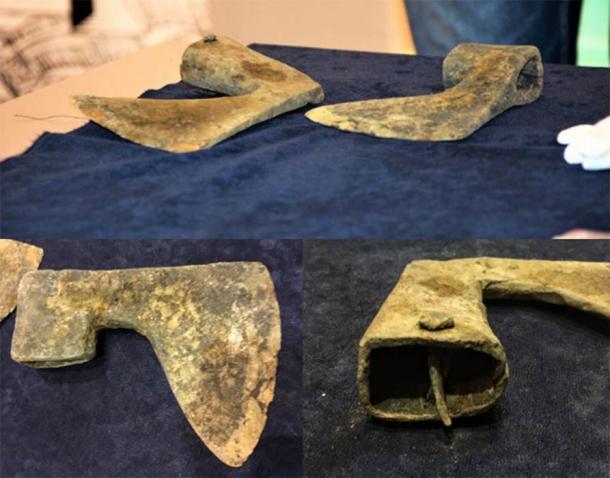
Incredibly well preserved 15 th century battle axes, likely used at the Battle of Grunwald. (Zwiadowca Historii )
Experts, based on the date of the weapons and their context, are sure that they were used in the Battle of Grunwald. Dr. Dreja told First News that “the context of these finds, the preliminary dating to the fifteenth century and the type of axes clearly indicate that they are directly related to the Battle of Grunwald of July 15, 1410.” This battle was one of the most important in all the Middle Ages and changed the history of Eastern Europe in particular.
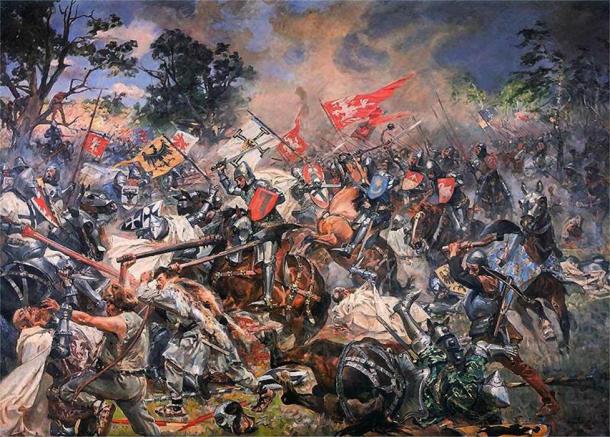
The Battle of Grunwald of 1410, seen in this 1931 oil painting by Wojciech Kossak, is of great importance to both the Polish and the Lithuanian people. ( Public domain )
50,000 Knights and Solders in Battle
The Battle was fought between the Knights of the Teutonic Order and a coalition of forces from the Kingdom of Poland and the Duchy of Lithuania. The Teutonic Order was originally a military order of monks that fought in the Crusades. Later they fought and conquered many of the pagan peoples of what is now the Baltic coast of Poland and the Baltic states. The Knights established a state in the area, and by the early 15 th century were a major power in Eastern Europe.
They came into conflict with the Poles and the Lithuanians. In July 1410 some 50,000 knights and soldiers fought a battle near the village of Grunwald. The Teutonic Knights , who had a fearsome reputation, were decisively defeated by the Poles and the Lithuanians. This was the beginning of the end of the power of the Teutonic Order. It also saw “the emergence of Poland-Lithuania as one of Europe’s most powerful states,” according to First News .
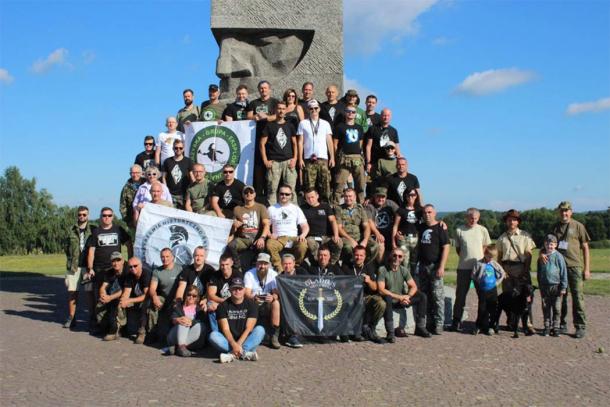
Every year the museum dedicated to the Battle of Grunwald organizes a mass research metal detector sweep of the battlefield site with the help of a large group of volunteers. This year was the seventh year they conducted the battlefield event. ( Muzeum Bitwy pod Grunwaldem )
What Other Mysteries Are Hidden at the Battlefield Site?
The axes that were uncovered in the marshy ground were probably melee weapons. They would have been used in close-quarter combat. These battle axes could have cut through some types of armor and caused terrible wounds. The museum has not identified the exact location of the axes and plan excavations at the site at some future date. A sword hilt was another of the prize finds.
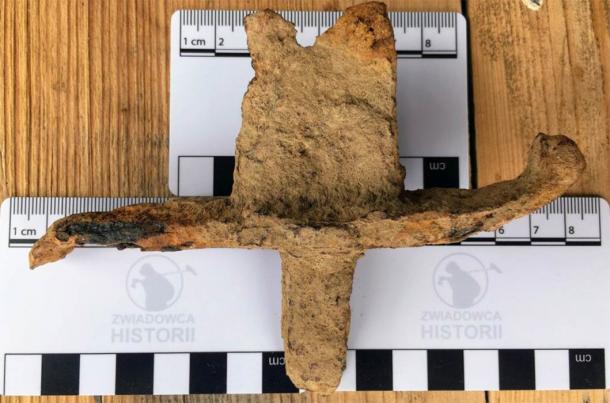
Sword hilt found at Grunwald site. ( Zwiadowca Historii )
Despite the recent sweeps of the battlefield site there are still many mysteries. Perhaps the most baffling is the location of the mass grave of the combatants who fought and died at the battle. Only 300 have been found so far near “the ruins of the chapel erected by the Teutonic Order in 1411” to commemorate the fallen, according to Grunwald Museum . However, documentary sources indicate that thousands died during the fighting.
The Battle of Grunwald is of great importance to both the Polish and the Lithuanian people. The battlefield site is marked by several monuments and it a popular tourist attraction due to its yearly reenactment of the battle . The Grunwald Museum has a permanent exhibition of the history of the battle and the history of the period. The discovery of the axes is showing the benefits of archaeologists collaborating with detectorists.
Top image: Battle axes from the Battle of Grunwald have been discovered during a sweep by volunteer metal detectorists in Poland. Source: Zwiadowca Historii
By Ed Whelan
 RSS Feed
RSS Feed















 September 1st, 2020
September 1st, 2020  Awake Goy
Awake Goy  Posted in
Posted in  Tags:
Tags: 













